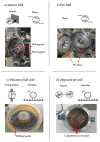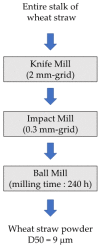Comminution of Dry Lignocellulosic Biomass: Part II. Technologies, Improvement of Milling Performances, and Security Issues
- PMID: 29932152
- PMCID: PMC6165348
- DOI: 10.3390/bioengineering5030050
Comminution of Dry Lignocellulosic Biomass: Part II. Technologies, Improvement of Milling Performances, and Security Issues
Abstract
Lignocellulosic feedstocks present a growing interest in many industrial processes as they are an ecological alternative to petroleum-based products. Generally, the size of plant raw materials needs to be reduced by milling step(s), to increase density, facilitate transport and storage, and to increase reactivity. However, this unit operation can prove to be important in term of investments, functioning costs, and energy consumption if the process is not fully adapted to the histological structure of the plant material, possibly challenging the profitability of the whole chain of the biomass conversion. In this paper, the different technologies that can be used for the milling of lignocellulosic biomass were reviewed and different avenues are suggested to improve the milling performances thanks to thermal pretreatments. Based on examples on wheat straw milling, the main points to take into consideration in the choice of a milling technologies have been highlighted in regards to the specifications of ground powder. A specific focus on the hazards associated to the milling and the manipulation of fine biomass particles is also realized at the end of the paper from the perspective of industrial applications.
Keywords: atex explosion hazard; cryogenic milling; energy consumption; grinding; milling; plant materials; torrefaction.
Conflict of interest statement
The authors declare no conflict of interest.
Figures





Similar articles
-
Fine Comminution of Pine Bark: How Does Mechanical Loading Influence Particles Properties and Milling Efficiency?Bioengineering (Basel). 2019 Nov 6;6(4):102. doi: 10.3390/bioengineering6040102. Bioengineering (Basel). 2019. PMID: 31698754 Free PMC article.
-
Comminution of Dry Lignocellulosic Biomass, a Review: Part I. From Fundamental Mechanisms to Milling Behaviour.Bioengineering (Basel). 2018 Jun 2;5(2):41. doi: 10.3390/bioengineering5020041. Bioengineering (Basel). 2018. PMID: 29865229 Free PMC article. Review.
-
Mineral-vegetal co-milling: An effective process to improve lignocellulosic biomass fine milling and to increase interweaving between mixed particles.Bioresour Technol. 2015 Sep;192:703-10. doi: 10.1016/j.biortech.2015.06.036. Epub 2015 Jun 12. Bioresour Technol. 2015. PMID: 26094197
-
Milling itineraries dataset for a collection of crop and wood by-products and granulometric properties of the resulting powders.Data Brief. 2020 Oct 23;33:106430. doi: 10.1016/j.dib.2020.106430. eCollection 2020 Dec. Data Brief. 2020. PMID: 33163591 Free PMC article.
-
Dry fractionation process as an important step in current and future lignocellulose biorefineries: a review.Bioresour Technol. 2013 Apr;134:362-73. doi: 10.1016/j.biortech.2013.01.169. Epub 2013 Feb 9. Bioresour Technol. 2013. PMID: 23499177 Review.
Cited by
-
Properties of biomass powders resulting from the fine comminution of lignocellulosic feedstocks by three types of ball-mill set-up.Open Res Eur. 2022 Mar 16;1:125. doi: 10.12688/openreseurope.14017.2. eCollection 2021. Open Res Eur. 2022. PMID: 37645205 Free PMC article.
-
Micromorphology and native extractive behaviour of wood powder.Sci Rep. 2024 Oct 26;14(1):25548. doi: 10.1038/s41598-024-75716-3. Sci Rep. 2024. PMID: 39462001 Free PMC article.
-
Polyhydroxybutyrate Rice Hull and Torrefied Rice Hull Biocomposites.Polymers (Basel). 2022 Sep 17;14(18):3882. doi: 10.3390/polym14183882. Polymers (Basel). 2022. PMID: 36146029 Free PMC article.
-
Fine Comminution of Pine Bark: How Does Mechanical Loading Influence Particles Properties and Milling Efficiency?Bioengineering (Basel). 2019 Nov 6;6(4):102. doi: 10.3390/bioengineering6040102. Bioengineering (Basel). 2019. PMID: 31698754 Free PMC article.
-
Research on the Grinding Energy Density in a Jet Mill.Materials (Basel). 2021 Apr 16;14(8):2008. doi: 10.3390/ma14082008. Materials (Basel). 2021. PMID: 33923669 Free PMC article.
References
-
- Womac R.A., Igathinathane C., Bitra P., Miu P., Yang T., Sokhansanj S., Narayan S. 2007 ASAE Annual Meeting. ASABE; St. Joseph, MI, USA: 2007. Biomass pre-processing size reduction with instrumented mills.
-
- Chevanan N., Womac R.A., Bitra V.S., Sokhansanj S. Effect of particle size distribution on loose-filled and tapped densities of selected biomass after knife mill size reduction. Appl. Eng. Agric. 2011;27:631. doi: 10.13031/2013.38194. - DOI
-
- Tannous K., Lam P.S., Sokhansanj S., Grace J.R. Physical properties for flow characterization of ground biomass from douglas fir wood. Part. Sci. Technol. 2013;31:291–300. doi: 10.1080/02726351.2012.732676. - DOI
-
- Trivelato P., Mayer-Laigle C., Barakat A., Fulcrand H., Aouf C. Douglas bark dry fractionation for polyphenols isolation: From forestry waste to added value products. Ind. Crop. Prod. 2016;86:12–15. doi: 10.1016/j.indcrop.2016.03.014. - DOI
-
- Motte J.-C., Delenne J.-Y., Barron C., Dubreucq E., Mayer-Laigle C. Elastic properties of packing of granulated cork: Effect of particle size. Ind. Crop. Prod. 2017;99:126–134. doi: 10.1016/j.indcrop.2017.01.043. - DOI
Publication types
LinkOut - more resources
Full Text Sources
Other Literature Sources

